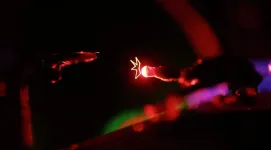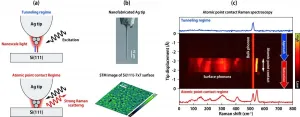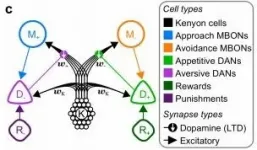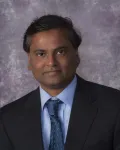Hologram experts can now create real-life images that move in the air
Using lasers to create the displays of science fiction, inspired by Star Wars and Star Trek
2021-05-07
(Press-News.org) They may be tiny weapons, but Brigham Young University's holography research group has figured out how to create lightsabers -- green for Yoda and red for Darth Vader, naturally -- with actual luminous beams rising from them.
Inspired by the displays of science fiction, the researchers have also engineered battles between equally small versions of the Starship Enterprise and a Klingon Battle Cruiser that incorporate photon torpedoes launching and striking the enemy vessel that you can see with the naked eye.
"What you're seeing in the scenes we create is real; there is nothing computer generated about them," said lead researcher Dan Smalley, a professor of electrical engineering at BYU. "This is not like the movies, where the lightsabers or the photon torpedoes never really existed in physical space. These are real, and if you look at them from any angle, you will see them existing in that space."
It's the latest work from Smalley and his team of researchers who garnered national and international attention three years ago when they figured out how to draw screenless, free-floating objects in space. Called optical trap displays, they're created by trapping a single particle in the air with a laser beam and then moving that particle around, leaving behind a laser-illuminated path that floats in midair; like a "a 3D printer for light."
The research group's new project, funded by a National Science Foundation CAREER grant, goes to the next level and produces simple animations in thin air. The development paves the way for an immersive experience where people can interact with holographic-like virtual objects that co-exist in their immediate space.
"Most 3D displays require you to look at a screen, but our technology allows us to create images floating in space -- and they're physical; not some mirage," Smalley said. "This technology can make it possible to create vibrant animated content that orbits around or crawls on or explodes out of every day physical objects."
To demonstrate that principle, the team has created virtual stick figures that walk in thin air. They were able to demonstrate the interaction between their virtual images and humans by having a student place a finger in the middle of the volumetric display and then film the same stick finger walking along and jumping off that finger.
Smalley and Rogers detail these and other recent breakthroughs in a new paper published in Nature Scientific Reports this month. The work overcomes a limiting factor to optical trap displays: wherein this technology lacks the ability to show virtual images, Smalley and Rogers show it is possible to simulate virtual images by employing a time-varying perspective projection backdrop.
"We can play some fancy tricks with motion parallax and we can make the display look a lot bigger than it physically is," Rogers said. "This methodology would allow us to create the illusion of a much deeper display up to theoretically an infinite size display."
INFORMATION:
[Attachments] See images for this press release:

ELSE PRESS RELEASES FROM THIS DATE:
2021-05-07
May 7, 2021 - Early in the COVID-19 pandemic, healthcare systems scrambled to modify patient care processes - particularly when it came to strategies aimed at reducing the risk of hospital-related complications. A look at how one hospital applied its learning health system (LHS) framework to respond to a COVID-19-related increase in hospital-acquired pressure injuries (HAPIs) is presented in the May/June Journal for Healthcare Quality (JHQ), the peer-reviewed journal of the National Association for Healthcare Quality (NAHQ). The journal is published in the Lippincott portfolio by Wolters Kluwer.
"Given the significant challenges ...
2021-05-07
Today, deliveries via cesarean sections, or c-sections, have become quite common globally. Sometimes, c-sections are a medical necessity when normal deliveries become risky either for the mother or the baby. At other times, it can be a choice. C-sections today have become a considerably safer procedure than it was a few decades ago, but there is need to refine it further.
In a END ...
2021-05-07
Children ages two to five who have the most common form of cystic fibrosis (CF), caused by two copies of the F508 gene mutation, have not had any modulator treatments available to them until recently. A new study authored by researchers at Children's Hospital Colorado and published May 6, 2021, in Lancet Respiratory Medicine shows that the CFTR modulator - lumacaftor/ivacaftor - can be safe and well-tolerated for this age range for up to 120 weeks, allowing younger children to begin proactive treatment of CF earlier in their lives.
CF affects more than 70,000 people worldwide and is a chronic, progressive, life-shortening genetic disease caused by an absent or defective protein called the CF transmembrane conductance regulator (CFTR) protein, resulting from mutations in both copies ...
2021-05-07
Despite their extremely small size, submicron atmospheric aerosols are critical pollutants with climate change, air quality, and human health implications. Of these particles, secondary organic aerosols (SOA) form when volatile organic compounds (VOCs) oxidize to lower volatility products that bond with and increase aerosol particle size, or in some cases, they may simply exist by themselves. SOA constitutes a significant fraction of the global aerosol mass. Scientists are attempting to improve future aerosol modeling, but several discrepancies still exist between model-simulated and field-observed SOA budgets.
''Large uncertainties in model assessments of SOA budgets and correspondingly, its climate effects, ...
2021-05-07
Nanofabrication of electronic devices has reached a single nanometer scale (10-9 m). The rapid advancement of nanoscience and nanotechnology now requires atomic-scale optical spectroscopy in order to characterize atomistic structures that will affect the properties and functions of the electronic devices.
The international team headed by Takashi Kumagai at Institute for Molecular Science discovered a huge enhancement of Raman scattering mediated by a formation of an atomic point contact between a plasmonic silver tip and a Si(111)-7×7 reconstructed surface. This was achieved by means of state-of-the-art low-temperature tip-enhanced ...
2021-05-07
Anesthestic drugs act on the brain but most anesthesiologists rely on heart rate, respiratory rate, and movement to infer whether surgery patients remain unconscious to the desired degree. In a new study, a research team based at MIT and Massachusetts General Hospital shows that a straightforward artificial intelligence approach, attuned to the kind of anesthetic being used, can yield algorithms that assess unconsciousness in patients based on brain activity with high accuracy and reliability.
"One of the things that is foremost in the minds of anesthesiologists is 'Do I have somebody who is lying in front of me who may be conscious and I don't realize it?' Being ...
2021-05-07
Even the humble fruit fly craves a dose of the happy hormone, according to a new study from the University of Sussex which shows how they may use dopamine to learn in a similar manner to humans.
Informatics experts at the University of Sussex have developed a new computational model that demonstrates a long sought after link between insect and mammalian learning, as detailed in a new paper published today in Nature Communications.
Incorporating anatomical and functional data from recent experiments, Dr James Bennett and colleagues modelled how the anatomy and physiology of the fruit fly's brain can support learning according to the reward prediction error (RPE) hypothesis.
The computational model indicates how dopamine neurons in an area of ...
2021-05-07
PITTSBURGH, May 7, 2021 - In a paper published today in Nature Communications, an international group of collaborators led by researchers at UPMC Children's Hospital of Pittsburgh have identified a genetic cause of a rare neurological disorder marked by developmental delay and loss of coordination, or ataxia.
The disorder, scientists found, is caused by mutations in a protein called GEMIN5--one of the key building blocks of a protein complex that controls RNA metabolism in neurons. No mutations in GEMIN5 were previously linked to any genetic disease. ...
2021-05-07
Luxembourg, 7 May 2021 - In a new position statement, Alzheimer Europe has issued a call for prioritisation of people with dementia and their carers in national COVID-19 vaccination strategies, urging governments to recognise the disproportionate effect of the pandemic on these groups.
Alzheimer Europe has today issued a call for people with dementia and their carers to be given priority in the ongoing COVID-19 vaccination campaigns across Europe.
In its position statement, Alzheimer Europe notes that people with dementia have almost twice the risk for developing COVID-19 compared to their ...
2021-05-07
Systemic inequalities mean that low-income households in London are more likely to be exposed to higher levels of indoor air pollution, according to a report by UCL researchers.
The biggest factors are the quality of housing and the characteristics of the surrounding environment, taking location and levels of outdoor air pollution into account - factors beyond occupants' control.
Air pollution exposure is the greatest environmental health threat in the UK, with long-term exposures estimated to cause 28,000-36,000 premature deaths a year.
In the paper, published in Buildings and Cities, researchers used available data and models, assembling evidence to examine five factors explaining why lower socio-economic groups may be exposed to higher levels of indoor air pollution ...
LAST 30 PRESS RELEASES:
[Press-News.org] Hologram experts can now create real-life images that move in the air
Using lasers to create the displays of science fiction, inspired by Star Wars and Star Trek








